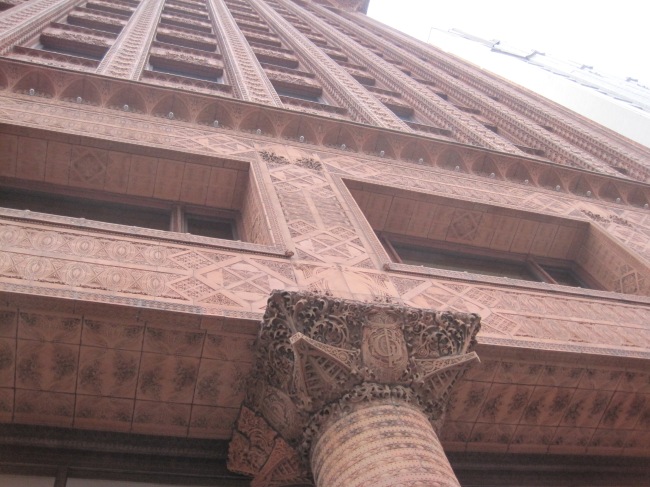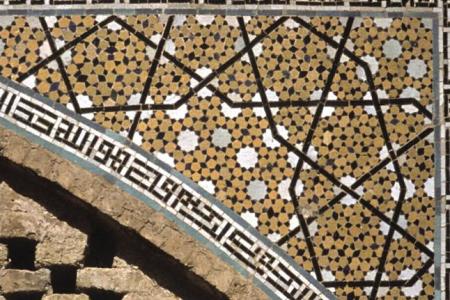By Kristen Olson
On March 22 and 23, I had the pleasure of attending Architectural Ceramics in the 21st Century: Design & Preservation of Contemporary & Historic Architecture, a conference sponsored by the Boston Society of Architects Historic Resources Committee, the MIT Department of Architecture – Building Technology Program, and Technology & Conservation Magazine. Joining me was Berta de Miguel, Vertical Access’ New York City Branch Manager. We heard over two dozen presentations, seemingly covering every aspect of architectural ceramics history, material properties, production, modes of failure, and conservation. Speakers included architects, conservators, historians, materials scientists, engineers, manufacturers, and even a Harvard physicist!
While the main title of the conference suggests a focus on new and innovative applications for architectural ceramics, there was plenty of discussion of the material’s historical development and on approaches to preservation.
Here are some highlights and takeaways from the weekend.
1. Ceramics have been used in architecture for a very long time. This image of the Ishtar Gate appeared in several of the presentations to demonstrate the astonishing durability of some ancient ceramics.

Encaustic floor tiles at Cleeve Abbey, Somerset, England, ca. 1250
2. There’s a lot more to architectural ceramics than terra cotta facades! “Architectural ceramics” encompasses roofing tile, structural terra cotta, nonstructural terra cotta cladding, floor tile, ceiling and wall tile, glazed brick, porcelain enameled surfaces, and superthick terra cotta pavers. New large-format, superthin ceramic panels are so thin that they can be installed over curved surfaces.

Coade Stone Lion, Westminster Bridge, London, 1837
3. We tend to think of the nineteenth century as the beginning of the revival of architectural terra cotta in the modern era, but Coade’s Artificial Stone Manufactory, under the ownership of Eleanor Coade, was producing a ceramic artificial stone as early as early as 1769. “Coade stone” was used for sculptures and architectural ornament, and proved to be remarkably durable.

Shepard Hall, City College of New York, designed by George B. Post, 1906
4. Terra cotta facades of the nineteenth and early twentieth centuries were often fraught with problems, including manufacturing defects, lack of waterproofing, poor detailing, and careless installation. The restoration of Shepard Hall at City College of New York by Robert Silman Associates and Stein White Nelligan Architects removed and replaced 65,000 pieces of deteriorated terra cotta.

Holburne Museum addition, Bath, England, designed by Eric Parry, 2011
5. Modern architectural ceramic products are of a much better quality than their counterparts of 100 years ago, and process improvements have reduced the environmental impact of their manufacture. But more information is needed about the long-term effects of different cleaning methods and coating products, and there are no published standards for terra cotta installation.

Guaranty Building, Buffalo, NY, designed by Adler & Sullivan, 1896
6. With a greater understanding of terra cotta’s materiality and how terra cotta systems perform, historic terra cotta facades are being successfully restored.

Federal Building and Post Office, Brooklyn, NY, 1891 (Mifflin Bell and William Freret) and 1933 (James Wetmore)
7. Terra cotta often masquerades as stone. The terra cotta cladding of the 1933 addition to the U.S. Post office in Brooklyn (right) was glazed to match the granite walls of the original 1891 wing (left).

Casa Batllo, Barcelona, designed by Antoni Gaudi, 1904
8. Architectural ceramics are also celebrated as a unique material with a natural affinity for colorful expression.

Ceramic tile mosaic at the Darb-e Imam shrine, Isfahan, Iran, ca. 1453
9. Peter Lu, a post-doctoral research fellow in the Department of Physics at Harvard, demonstrated that medieval Islamic architects were able to create non-repeating tile patterns with fivefold rotational symmetry – a feat not achieved by western mathematicians for another five hundred years. These patterns, created using girih tiles, were executed in ceramic tile mosaic and other media beginning in the thirteenth century.
10. Continuing on the mosaic theme were videos on the excavation of the Lod Mosaic and the construction of the Moroccan Court at the Metropolitan Museum of Art.

Guastavino tile vaults in the crypt chapel of the Church of the Intercession, designed by Bertram Goodhue, 1915
11. Of course, a conference on architectural ceramics wouldn’t be complete without some Guastavino! MIT Professor of Civil and Environmental Engineering John Ochsendorf gave an overview of the Guastavino family’s innovations in ceramic technology and identified preservation challenges.
It was an action-packed couple of days, and we’re looking forward to the next conference in this series!
Guaranty Building and Church of the Intercession photos by Kristen Olson. All other photos via Wikimedia Commons.
